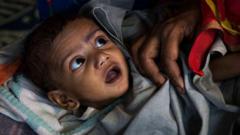A study reveals that caste discrimination significantly contributes to India's alarming child stunting rates, uncovering the role of social identity in nutrition-related issues that eclipses physical measurements alone.
Unraveling India's Stunting Crisis: The Impact of Caste Discrimination

Unraveling India's Stunting Crisis: The Impact of Caste Discrimination
New research links India's child stunting rates to long-standing caste hierarchies, highlighting crucial social factors often overlooked in nutritional discourse.
India faces a troubling child stunting crisis, with official data revealing that 35% of its 137 million children under five are stunted— a stark contrast to the average rate of 33.6% across Sub-Saharan Africa. While both regions account for a significant share of the world's malnourished children, research by Ashwini Deshpande and Rajesh Ramachandran suggests that the higher rates in India can be largely attributed to entrenched caste discrimination.
Stunting, characterized by children falling short of the expected height for their age, is a critical indicator of malnutrition and emerges primarily from deficiencies in nutrition, healthcare, and a safe living environment during the first 1,000 days of a child’s life, considered a "golden period" for brain development. The urgency of addressing these nutritional gaps is underscored by the shared challenges of poverty and development in India and Sub-Saharan Africa, where the World Bank has reported both regions account for over 85% of global poverty.
The study examined the stunting phenomenon among various socially disadvantaged groups in India, such as adivasis and Dalits, who account for more than one-third of the under-five population. It determined that children belonging to higher caste groups experienced stunting at a rate of 27%, considerably lower than those from marginalised backgrounds. Even after accounting for various influencing factors, the data indicated that children from lower-ranked caste groups were 20% more likely to be stunted.
Despite decades of affirmative action in India, the caste system has proven resilient, continuing to impact the nutritional outcomes of marginalized communities. Compelling debates have emerged around the origins of these disparities, including suggestions of genetic predispositions, but the authors emphasize that social and economic factors, particularly surrounding access to nutrition and healthcare, are critical to understanding the ongoing crisis.
Research shows that stunting levels have declined across various social groups, indicating progress due to health interventions and improved living conditions. Nonetheless, children from low-income families or those with less-educated mothers remain particularly vulnerable. The authors contend that the discourse on stunting often neglects the vital influence of caste identity, which is essential for addressing the crisis effectively.
Through a comprehensive analysis of anthropometric data from over 397,000 children under five in India and Sub-Saharan Africa collected in recent years, the study aims to bring awareness to the importance of social identity in child nutrition discussions and inspire targeted solutions to improve outcomes for the most vulnerable populations in India.




















